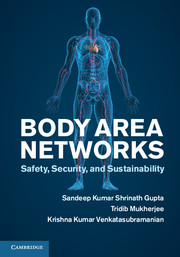Book contents
3 - BAN models and requirements
Published online by Cambridge University Press: 05 April 2013
Summary
In this book, we mainly focus on the pervasive health-monitoring system (PHMS), where the BAN nodes act as medical devices. Stand-alone BANs are typically ineffective due to their low computation and storage capability and limited battery life, especially when used in a PHMS setting. Thus, in PHMSes a BAN is usually used in conjunction with high-end embedded devices such as the smart phone and cloud-based computational and storage resources. Figure 3.1 shows the basic hardware architecture of a PHMS with the BAN deployed on the human body, communicating to a smart phone, which has limited storage and higher computation capability. The smart phone in turn uses the cloud for further processing and storage related to diagnosis and other applications. There have been different implementations of this basic architecture of a PHMS, each assuming different capabilities of the BAN, smart phone, and cloud. From a survey of the health-monitoring applications available on the market (at the time of writing this book), three categories of PHMS implementations have been identified.
In the first category, the sensors are considered to be merely data-collection units with no computation and storage. The sensors are merely monitoring devices and are not approved as marketable medical devices by the FDA in the USA. The smart phone acts as the primary computation device; it performs signal processing on the physiological signals and displays results to the user. […]
- Type
- Chapter
- Information
- Body Area NetworksSafety, Security, and Sustainability, pp. 26 - 35Publisher: Cambridge University PressPrint publication year: 2013



